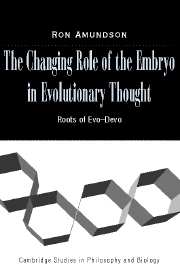Book contents
- Frontmatter
- Contents
- Acknowledgments
- 1 Introduction
- PART I DARWIN'S CENTURY: BEYOND THE ESSENTIALISM STORY
- 2 Systematics and the Birth of the Natural System
- 3 The Origins of Morphology, the Science of Form
- 4 Owen and Darwin, The Archetype and the Ancestor
- 5 Evolutionary Morphology: The First Generation of Evolutionists
- 6 Interlude
- PART II NEO-DARWIN'S CENTURY: EXPLAINING THE ABSENCE AND THE REAPPEARANCE OF DEVELOPMENT IN EVOLUTIONARY THOUGHT
- References
- Index
5 - Evolutionary Morphology: The First Generation of Evolutionists
Published online by Cambridge University Press: 05 June 2012
- Frontmatter
- Contents
- Acknowledgments
- 1 Introduction
- PART I DARWIN'S CENTURY: BEYOND THE ESSENTIALISM STORY
- 2 Systematics and the Birth of the Natural System
- 3 The Origins of Morphology, the Science of Form
- 4 Owen and Darwin, The Archetype and the Ancestor
- 5 Evolutionary Morphology: The First Generation of Evolutionists
- 6 Interlude
- PART II NEO-DARWIN'S CENTURY: EXPLAINING THE ABSENCE AND THE REAPPEARANCE OF DEVELOPMENT IN EVOLUTIONARY THOUGHT
- References
- Index
Summary
THE PROGRAM OF EVOLUTIONARY MORPHOLOGY
The research program of evolutionary morphology comprised “the first generation of evolutionary biologists” (Bowler 1996: 14). It arose soon after the 1859 publication of the Origin. By the turn of the century, it had almost completely died out. Most of its adherents had turned away from phylogenetic studies and toward the experimental study of embryology and genetics. Depending on one's theoretical commitments, evolutionary morphology was either the last gasp of the metaphysically flawed program of idealist morphology, or else the birth of the promising program of evolutionary developmental biology. I favor the latter interpretation. Peter Bowler favors the former. Both points of view are discussed in this chapter.
Peter Bowler has written three extraordinarily valuable books on the history of this period (Bowler 1983, 1988, 1996). He was among the first historians to examine the contrast between modern neo-Darwinian theory and the views on evolution that preceded the Evolutionary Synthesis. The late nineteenth century has received much less historical attention than the period just prior to the Origin. Bowler's work fills an important historical gap, and it presents us with an intriguing and (at first sight) surprising report on how very different the evolutionary theorizing of that period was from that of the mid-twentieth century. I am extremely indebted to this work, but I have one important disagreement with its author. I consider Bowler's histories of the period to be more important than he considers them.
- Type
- Chapter
- Information
- The Changing Role of the Embryo in Evolutionary ThoughtRoots of Evo-Devo, pp. 107 - 129Publisher: Cambridge University PressPrint publication year: 2005



